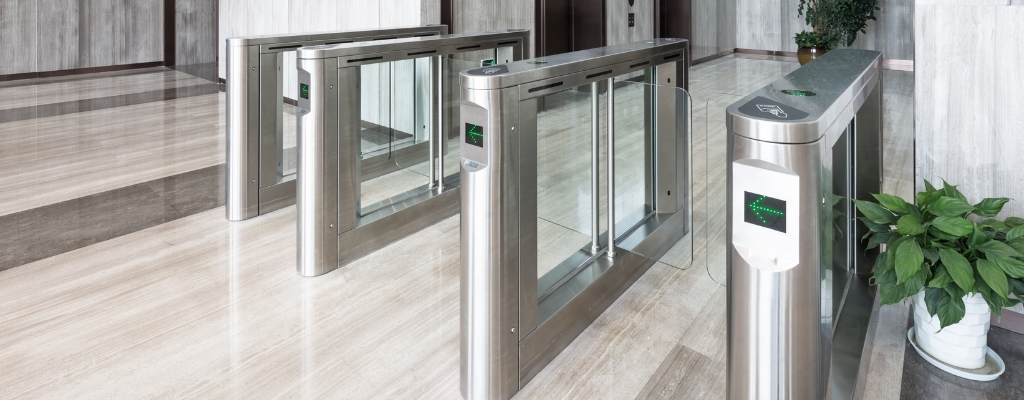As the world changes, so should your access control security. Cloud-based access control is replacing slower, less flexible on-premises systems and robust features are helping IT and security teams automate their security processes. When used in combination with API integrations, cloud-based security gives security teams at enterprises, schools, hospitals and more the power to unify their security stack from a single pane of glass.
In this guide, we’ll discuss:
- What is an access control system?
- What is the difference between proprietary and open access control hardware?
- What are the parts of a security system?
- Choosing between cloud security and on-premises security
- What is single pane of glass security?
- The benefit of API integrations for physical access control
- Access control credentials
- Important security features
- Choosing the best access control security
Let’s look at how you can automate your security processes and manage your physical security with advanced access control.
What is Access Control?
First things first…what is access control?
Access control is the process of regulating and managing the security of an area, data or other assets.
Two types of access control exist: logical and physical. Physical access control limits access to physical areas like offices, buildings, schools, campuses and more. Logical access control limits connections to computer networks, system files and data.
To safeguard a facility, organizations can employ a physical electronic access control system that uses user credentials, access card readers, auditing and reporting mechanisms. These systems are designed to monitor and regulate employee access to restricted locations. Certain systems integrate access control panels to limit entry to specific rooms and buildings, along with alarms and lockdown features to prevent unauthorized access or activities. Security teams can then assign credentials to their employees or visitors to access these areas.
Later, we’ll cover credentials in more detail. However, for the time being, there are different forms of credentials such as key cards, digital badges on mobile devices and biometrics.
Tip: Sometimes a combination of credentials is used in two-factor authentication (2FA) or muti-factor authentication.
For more information about access control systems, see our resources:
Access Control Installation: A Guide
What is Physical Access Control? – Modern Security Systems
Best Access Control Systems of 2024
5 Different Types of Access Control
Genea Security vs. Avigilon Alta (formerly Openpath)
Best Access Control Systems of 2024: Genea vs. Verkada
Why are Access Control Systems Important?
Access control increases security and safety. It helps protect the people at your facility, sensitive information and physical assets. By implementing a robust access control security system, IT and security teams can better mitigate the risk of theft, vandalism or other security breaches.
Additionally, physical access control contributes to compliance with regulatory standards and enhances emergency response capabilities. Beyond security, access control fosters a sense of order and privacy, creating a more productive and comfortable environment for occupants.
Let’s review the factors to consider when choosing the right access control system.
Non-proprietary or Proprietary Hardware for Security
One of the first decisions IT and security teams must make about their access control security is whether to choose proprietary or non-proprietary hardware.
Non-proprietary access control is a way for organizations to avoid being tied to or restricted to a particular access control provider. Conversely, proprietary access control allows security teams to use only the software and hardware provided by a single manufacturer.
Non-proprietary access control
Non-proprietary access control is not tied to technology or protocols owned by a specific vendor. Technology and standards used in the access control system are open or interoperable. As a result, users gain greater flexibility, compatibility and freedom of the software they use. They are not locked into a single vendor’s products or solutions. Non-proprietary access control systems promote widespread adoption and integration with a variety of hardware and software components.
Proprietary access control
Proprietary access control locks in users to one security provider. Users must install hardware and software manufactured by the provider. If a user wants to switch software providers after a proprietary system has been installed, then they must rip and replace their hardware. This often leads to unnecessary expenses.
Components of an Access Control System
Whether you choose proprietary or non-proprietary hardware, your system will include a variety of components like door locks, controllers, card readers, cables and more. For detailed information about these components take a look at some of the following resources:
Access Control Installation: A Complete Guide
Access Control Systems: The Differences Explained
The Risks of Proprietary Access Control Door Hardware
Proprietary vs. Open Hardware—Open Access Control System
Access Control Panels: An Overview
The Pros and Cons of Proximity Card Reader Systems
What’s the Difference between Electric Locks and Magnetic Locks?
Wireless Door Locks for Security
Cloud-based or On-prem Access Control
A significant transformation in the past decade, as it relates to access control, pertains to how and where information is stored.
Traditionally, organizations used on-premises access control systems as their primary means of security. These systems required routine maintenance to the servers housed on site. The maintenance was performed by internal IT and security teams. Consequently, these teams had to dedicate time, capital and personnel to deal with these on-premises servers. The cloud changed this.
With cloud-based access control, severs store data off site and are maintained by a third-party vendor, allowing internal IT and security teams to concentrate on other important tasks. Some examples of vendors include AWS and Google. But the advantage of using the cloud goes far beyond storage. IT and security teams also benefit from:
- Remote Access– Monitor and provision whether working on site or remotely.
- Connect Your Enterprise– Centralize your physical security system across your entire enterprise.
- API Integrations– Cloud-based access control systems integrate with other software platforms more easily than on-prem access control.
To learn more about the difference between on-premises and cloud-based access control security, read our articles below.
Cloud-Based Access Control vs. On-premises
8 Benefits of Cloud-based Access Control Systems
What is an Access Control Takeover?
How Much Does an Access Control System Cost in 2024?
What is Cloud Architecture for Access Control?
Cloud Access Control: How It Saves Time and Money
Access Control from a Single Pane of Glass
As access control technology continues to advance, IT and security teams should aim to find solutions that connect and unify their software stack. “Single pane of glass” access control security accomplishes this. With a single pane of glass security system, organizations can centralize their chat systems, video cameras, directory services and more from a unified platform.
Below are some of the integrations made possible from a single pane of glass access control system.
API Integrations for Access Control Security
- Video Management is the recording and storing of video footage captured by surveillance cameras for security, monitoring or other purposes. By integrating access control and video management, like Milestone, Cisco Meraki, Eagle Eye and others, IT and security teams can view video footage alongside door access events.
- Chat Systems are communication platforms that enable real-time, text-based interactions between users over the internet such as Microsoft Teams or Slack. Chat systems help alert users of access events.
- Visitor Management Systems make the guest experience more convenient. Commercial real estate and enterprise teams can customize the visitor journey with time-sensitive QR code access badges, pre-visit NDAs, health questionnaires and more.
- Elevator Integrations, like destination dispatch services from Otis and Schindler, help guide building guests, staff and employees to the areas they need to be.
- Directory Integrations automate the adding and removing of users by integrating your Okta, Azure AD or Google Workspace databases with your security software.
Here are some helpful articles about integrating your technology stack with Genea Security:
The Power of a Single Pane of Glass for Physical Access Control
Cloud Access Control and the Importance of API Integrations
Cloud-Based Security Camera Systems for Enterprises Guide
Genea Security + Arcules Video Management
Access Control + Visitor Management
A Single Pane of Glass: Why Centralized Security is Necessary – Whitepaper – Genea (getgenea.com)
Choosing Your Access Control Credentials
Access credentials are one of the important parts of a security system. Credentials are distributed to users (e.g., employees, visitors, staff, etc.) and used to gain access to authorized spaces within a building. After assigning individual privileges within a database and programming them onto an access token, IT and security teams distribute the credential to the user. In turn, the user scans or shows their credential to a door reader when attempting access.
There are a variety of credentials options and choosing the right one depends upon your need. Here are a few options:
Types of Access Credentials
- Mobile (Smartphones)
- Key Cards (Prox Cards or Smartcards)
- Key Fobs
- Biometrics (Fingerprints, retina scans)
Access control credentials use Bluetooth or NFC (which uses radio frequency identification (RFID)) to communicate with the door reader. Each credential type presents unique advantages, from heightened security to user convenience. Choosing the right combination of credentials allows organizations to create a robust access control system that aligns with their specific requirements and priorities.
The Quick and Essential Guide to Mobile Access Control Systems in 2024
Apple Wallet Integration – How Genea Works with Apple Wallet
Mobile or Card Access Control – Solutions For Businesses
Security differences between prox cards and mobile credentialing
Key Card Entry System Security: NFC vs RFID
Understanding the Differences Between NFC and Bluetooth – Whitepaper
Important Features for Your Security System
With so many choices in security technology today, it’s easier to optimize a security system to your liking. Further, cloud-based systems include robust features which make customization options endless.
Common access control system features include, but are not limited to:
- Restricting access for different areas of facilities
- Access management for different employees
- Remote management via internet or mobile app
- Integration with video surveillance, chat systems and more
- Ability to receive alerts and notifications for suspicious activity
- Interactive floor plans
- Schedule access according to time and day
Access Control for Different Industries
The type of industry in which you operate will also influence the security system you implement. Explore some of the helpful, industry-specific information linked below.
Top 5 Benefits of Enterprise Access Control Systems
Access Control Security: Types for Commercial Properties
Access Control for Small Business
Access Control for Enterprises
Access Control for Small Business: Why Every Small Business Needs an Access Control System
Why Fast-Growing Companies Need Cloud-Based Access Control
Choosing the Right Access Control System
Once you have decided on your security needs, choosing the right access control system is critical in developing a functional security protocol.
Genea’s cloud-based security platform helps IT and security teams manage their entire security infrastructure from a single pane of glass. Built on non-proprietary hardware HID and Mercury hardware, we give you the flexibility needed to easily make changes in the future without expensive ripping and replacing.
Additionally, our platform offers the perfect balance of security and convenience with easy-to-use API integrations. Provision credentials in physical and mobile forms whether you’re working on site or remotely. You can even distribute employee credentials directly into Apple Wallet.
Most of all, Genea provides 24/7/365 customer service, including a direct line to our product team. So, you get the help you need, whenever you need it. See why Genea is trusted by industry-leading enterprises, commercial building teams, schools and more by speaking with a representative today.



